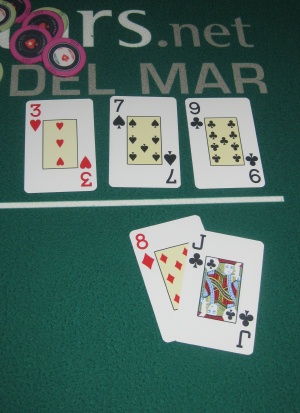|
|

Belly Buster - An inside straight draw.
A “belly buster” draw is slang terminology for an inside
straight draw. There are many different nicknames for
the various types of straight draws a player will face. These are usually descriptive in nature, because of a need to differentiate
between straight draws with differing values. The value of a straight draw can vary quite widely, and is affected not only by the innate
quality of the draw, but also by the situation the player finds himself in. Some of these differences in value are subtle, and some are
more obvious. Much of this is due to the fact that different types of straight draws will have different probabilities of being
completed as well as different probabilities of holding up when completed.
Straight draws are often classified by the layout of the draw and the number of natural
outs the draw contains. For example, a straight draw can
either be a “gutshot” or belly buster, a “double” gutshot (or double belly buster), or an “open ended” draw.
The belly buster draw is typically the least valuable draw of the three. It is an “inside” or “middle” straight draw, which means that
if the player is to complete the straight, a card must be hit on the inside, or in the middle of the draw. For example, if a player held
4♠ 5♣ 7♦ 8♥, he must catch an “inside six” in order to complete his hand. This type of draw is significantly less valuable
than both the double belly buster, and open ended variety. This is because it can only be completed with one rank of card, whereas the double
bellybuster and open ended draws may be completed with either of two ranks. Obviously, having only one card available, as opposed to
two, cuts your number of outs in half. This makes you half as likely to complete your draw, and significantly lowers the value of the
draw. In fact, it often lowers the value of the draw to the point where it has negative value and is not worth taking. Many bad players
either don’t understand this, or don’t have the discipline to throw away their hand when they face a draw they shouldn’t take. For this
reason, belly buster draws are often associated with bad play, because they frequently require making a bad call in order to complete.
The double bellybuster draw, like the bellybuster, requires that a card be hit on the inside. The similarities pretty much end there.
Its value more closely resembles that of the open ended draw, because it also contains eight outs. It requires that six cards be in
play, while the belly buster draw can happen on the flop. An example of a double belly buster draw would be 4♠ 6♠ 7♦ 8♥ T♣.
You can see that this straight can be completed with either a five or a nine.
The open ended draw is slightly different. It contains four consecutive cards, allowing the player to hit on either end of the draw for
completion. Like the double belly buster, the open ended draw contains eight outs. These outs are always on either end of the draw
rather than in the middle. An example of an open ended draw would be 4♠ 5♣ 6♠ 7♦. This straight can be completed by hitting either a
three or an eight.
The double belly buster and open ended draw are similar inasmuch as they both can be completed by two differently ranked cards rather
than only one. Assuming that you have no dead cards, they both will have eight outs. The main difference between these two draws is the
layout. The double belly buster requires an inside hit from one of two ranked cards, whereas the open ended draw requires an outside hit
from one of two ranked cards. This leads to the open ended draw being slightly more valuable than the double bellybuster, primarily
because it makes the nuts far more frequently.
One thing that can have a profound impact on the value of a straight draw is layout of your open cards and hidden cards. If you are
playing in a flop game, like Hold’em, the open cards are the board cards, and the hidden cards are your hole cards. Generally speaking,
you want to have the higher value cards hidden, and the lower value cards in your hand.
Consider again the double belly buster draw of 4♠ 6♠ 7♦ 8♥ T♣. If your hole cards are 8♥ T♣,
and the board reads 4♠ 6♠ 7♦, you are in much better shape than you would be if the board read 7♦ 8♥ T♣
and your hole cards were 4♠ 6♠. This is because in the former case you are drawing to the top end of the straight, and in the later
case you are drawing to the bottom end. You can see that when you draw to the bottom end of the straight, even when you complete your hand,
you will often lose to a player who is drawing to the top end. This effect is magnified with open ended draws. Consider a board of 6♠
7♦ K♣. A player holding 8♥ 9♣ will do considerably better in the long run than a player holding 4♠ 5♣.
You can see that several factors affect the quality of your straight draw. The number of natural outs that you have is a key component.
Whether you need to hit on the inside or outside can affect value. Which cards are hidden and which cards are open is also of critical
importance. Quite often, you will not know if your draw has value until you consider all of this and calculate your pot odds or implied odds.
Usage: Belly Buster Straight, Double Belly Buster Straight Draw, Hit In the Belly
Previous Poker Term: Behind
Next Poker Term: Bet
|
|







